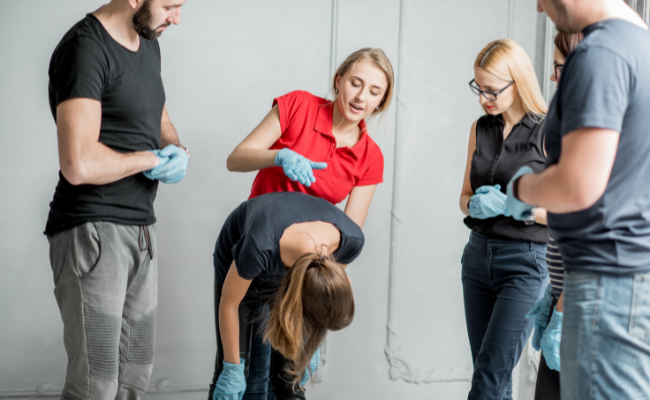What to do incase of First Aid For Choking?
- November 14, 2023
- No Comments

What is First Aid for Choking?
First aid for choking involves prompt and potentially life-saving actions taken to aid an individual facing airway blockage, causing breathing difficulty. This situation arises when a foreign object, such as food, obstructs the airway, impeding the flow of air. Choking, marked by the hindrance of vital oxygen to the lungs and brain, poses a serious threat. A delay exceeding 4 minutes in providing oxygen can lead to brain damage or death. Recognizing and knowing how to react to choking is vital, whether at home or in public. Experts recommend immediate measures like back blows and abdominal thrusts for aiding adults or children aged one year and older experiencing a choking episode.
Why is First Aid for Choking Necessary?
Choking is a critical emergency that demands quick and effective intervention. When an object obstructs the airway, it can lead to a lack of oxygen, potentially causing serious harm or even death within minutes. Prompt first aid for choking is crucial to dislodge the obstructing item and restore normal breathing.
How to Perform First Aid for Choking?
- Assess the Situation: Quickly evaluate the severity of the choking situation. Determine if the person is able to cough, speak, or breathe. If the individual is unable to breathe or is experiencing severe distress, immediate action is necessary.
- Encourage Coughing: If the person is coughing forcefully, it is an indication that some air is moving, and the blockage may be partial. Encourage continued coughing to help dislodge the object.
- Perform Back Blows: If coughing is ineffective, proceed to perform back blows. Stand behind the person, slightly to the side. Place one arm across their chest for support and bend them forward. Deliver firm blows between the shoulder blades using the heel of your hand.
- Perform Abdominal Thrusts (Heimlich Maneuver): If back blows do not resolve the choking, move on to abdominal thrusts. Stand behind the person, place your arms around their waist, and make a fist. Position the thumb side against the middle of the person's abdomen, above the navel. Grasp the fist with your other hand and deliver quick, upward thrusts.
- Continue Cycle: Alternate between back blows and abdominal thrusts until the object is expelled, the person can breathe, or emergency medical help arrives.
Treatment Solutions for First Aid for Choking:
- Emergency Medical Assistance: If the person is unable to breathe, loses consciousness, or the choking persists, call emergency services immediately. Provide information about the situation and follow their instructions.
- CPR (Cardiopulmonary Resuscitation): If the person becomes unconscious, initiate CPR. Begin with chest compressions and rescue breaths. Continue until emergency medical help arrives or the person starts breathing on their own.
- Seek Professional Medical Evaluation: Even if the choking incident seems to resolve, it is advisable to seek medical attention for a professional evaluation to ensure there are no underlying issues or injuries.
Benefit Points of First Aid for Choking:
- Rapid Response Saves Lives: Immediate first aid for choking can be the difference between life and death. Rapid response increases the chances of dislodging the obstructing object and restoring normal breathing.
- Minimizes Risk of Complications: Swift and effective first aid reduces the risk of complications such as lack of oxygen to the brain, cardiac arrest, or other serious consequences associated with prolonged choking incidents.
- Empowers Bystanders: Knowing how to perform first aid for choking empowers individuals to take action in emergency situations. Basic knowledge and quick response can make a significant impact on the outcome.
- Prevents Long-Term Damage: Timely intervention helps prevent long-term damage to the airways and surrounding tissues. Minimizing the duration of the choking incident reduces the risk of lasting harm.
- Supports Professional Medical Care: While first aid is essential in the immediate response to choking, it also sets the stage for professional medical care. Seeking emergency assistance ensures a comprehensive evaluation and follow-up care.
- Boosts Confidence: Knowledge of first aid for choking instills confidence in individuals, enabling them to respond effectively in emergency situations. Confidence in one's ability to provide assistance can be invaluable in critical moments.
Comments (0)